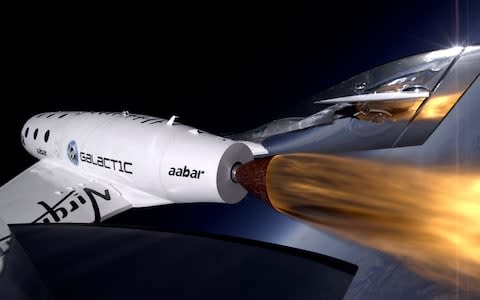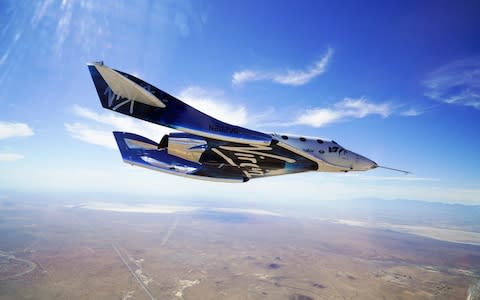Virgin Galactic preparing to send first commercial pilots into space

Virgin Galactic is poised to send its test pilots into space for the first time on Thursday, marking a major milestone in the race towards commercial space travel.
The flight will be the first time that man has gone to space from US soil since Nasa shut down the space shuttle programme, in July 2011.
“It’s a day we’ve been waiting for for a long time,” said George Whiteside, CEO of Virgin Galactic and The Spaceship Company, a manufacturer of advanced space vehicles.
Sir Richard Branson, who founded Virgin Galactic in 2004, originally promised suborbital flights – those that reach space without orbiting the planet – by 2009. But the firm’s plans have been delayed by numerous setbacks and the loss of the company’s previous space plane in a 2014 accident that killed co-pilot Michael Alsbury.
“We’ve had our challenges,” said Mr Whitesides. “But to get to the point where we are at least in range of space flight is a big deal.”

Virgin Galactic’s site, high in the Mojave Desert 100 miles north of Los Angeles, was abuzz with excitement on Wednesday, as the launch time crept closer.
As Sir Richard made tea for the team, Mr Whiteside explained that the two pilots will take off at dawn and attempt to fly to 50 miles above the Earth – Nasa’s definition of space.
Their craft, VSS Unity, will eventually hold six paying passengers, but on Thursday it will be just the two test pilots, plus a series of scientific instruments, and “Annie”, a mannequin fitted with sensors to study the effect of the journey on the body.
“She’s coming along for the ride,” joked Mike Moses, president of Virgin Galactic, as he showed off for the first time the delicate pre-flight preparations on the eve of the launch. Virgin has never before permitted access to the hangar prior to a test flight.
Dozens of technicians were making final checks on Wednesday, inspecting the screws in both VSS Unity and the mothership, VMS Eve, and torque testing the panels.
Earlier the test pilots had carried out a final trial run inside the simulator – a black-curtained cockpit in the corner of the hangar, where the curved screen provided a breathtaking vision of what the pilots would see from 50 miles above earth, as the atmosphere ends and the darkness of space begins.

The hangar hummed with quiet focus; the team of 750 employees excited for the challenge of the next day.
“We are essentially learning how to best fly the trajectory to space,” said Mr Whitesides. “The craft will be flown to space – it’s not computer driven. So we’re learning the best piloting techniques.”
At 7am ET (midday GMT) on Thursday, if conditions are right, VMS Eve – named after Sir Richard’s mother – will take off with VSS Unity attached. Climbing for around 45 minutes to a height of around 43,000ft, VSS Unity will then be released from VMS Eve. The pilots will pull the nose of the space craft sharply upwards for around 50 seconds – longer than ever before – and jet into the skies with a force approaching Mach three, travelling at almost three times the speed of sound.
At its maximum height, the pilots will turn the craft upside down, so that the eventual passengers, weightless by now, can see the Earth below them. For several minutes they will stay at that height, taking in the view of 500 miles in every direction, before beginning the descent.

“Gliding back down is relaxed – a nice welcome back to Earth,” said Todd Ericson, the vice president of safety and test, and a former F-16 fighter jet pilot who is also one of the test pilots.
The most challenging part, he said, was the pivot upwards to go into space.
“If this flight is relatively successful, I think we’ll be in a position to go to a full-duration flight,” added Mr Whitesides.
Virgin Galactic has not set a date for its first commercial space flight, for which around 700 people, including Leonardo DiCaprio, Tom Hanks and Justin Bieber have signed up, paying $250,000 (£192,000).

But many people expect it to happen within a year, and Sir Richard has said he will be on the first trip, leaving the company’s New Mexico spaceport.
Virgin Galactic’s main rival, Blue Origin, owned by billionaire Amazon founder Jeff Bezos, has flown higher, but in a computer-operated craft, rather than one piloted by humans. They too are hoping to take their first commercial passengers in 2019.
SpaceX, the company owned by Elon Musk, is focused on carrying equipment for Nasa’s programmes – although they do hope to take a Japanese billionaire around the moon by 2023.
“This is a test flight, a no-kidding test flight, with all the novelty and excitement and risk,” said Mr Whitesides, on the eve of the flight.
He was determined, he said, “to share that risk is a valuable part of forward progress.”
The pilots may not decide to push for space on Thursday, and the conditions may not be right. Part of the process, he said, was checking how accurate their computer-generated models were against actual flight data.
“I think it’s rare in modern society to bring people into the test flight,” he said. “It’s usually a pretty protected environment.
“But I think it’s really important.”

 Yahoo News
Yahoo News 